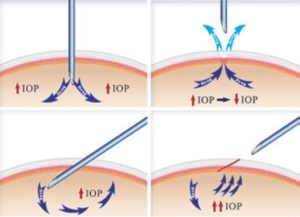Oblique (Angled) Injection Technique Improves the Delivery of Avastin Treatment
Intravitreal (IVT) injections are the most common surgical procedure in ophthalmology practice today. In fact, it is projected that millions of these injections are given each year in the United States. Ocular oncologists use intravitreal injections to treat such conditions as cystoid macular edema (CME), radiation retinopathy, and neovascularization. But did you know that the technique of delivering the injection can influence the effectiveness and safety of treatment?
Following IVT injection, some medication can actually egress or leave the eye through the port of entry, thus delivering less medication than what the physician intended. This can lead to under-treatment of the disease. The perfect IVT injection delivers an exact amount of medication with the least risk to vision and the eye.
Mehta and Finger used a technique of oblique (or angled) IVT injection in an effort to minimize the amount of medication leaving the eye. IVT injection was delivered at a 30-45 degree angle and compared to the standard technique of using a perpendicular (orthogonal) angle.
The researchers found that the angled IVT injection technique had a significantly higher mean intraocular pressure immediately after the injection. This finding suggests that angled injections are self-sealing and more of the drug is staying in the eye. Thus, the angled technique delivers a more accurate dose as well as prevents intraocular infection by closing a potential entry for pathogens.
The Figure below shows how the angled technique may allow for better retention of the drug within the eye following injection:
Through PubMed, you are able to read the published scientific article that explains this in detail here. To stay tuned on all the latest in eye cancer research, please keep our website, eyecancer.com, in your bookmarks!










